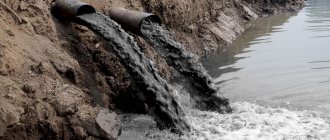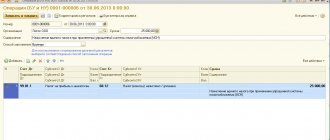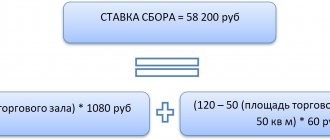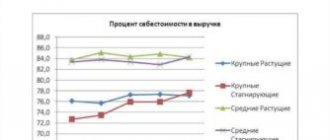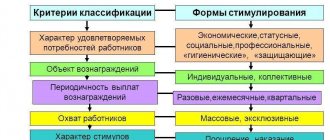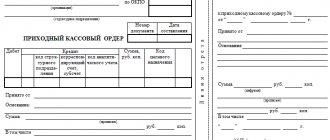How to determine whether you need to pay an environmental fee and prepare reports
In 2020, Rosprirodnadzor issued Order No. 488, which specifies the payer and the amount of the environmental fee. The final environmental fee (EC) depends on 3 factors:
- eco-fee rates;
- mass of finished or packaging products produced;
- recycling standards.
The rate is approved by the state. The amount is indicated on the official website of Rosprirodnadzor.
The rate depends on 3 factors:
- environmental hazard category;
- type of product;
- complexity of the recycling process.
When deciding who pays the ES, you need to rely on Russian legislation and the specified scheme:
- If an organization/individual entrepreneur produces or imports products and containers not listed in the list, the non-tax payment is not paid.
- If a manufacturer or individual entrepreneur produces goods and packaging material included in the list, then the accounting department generates reports calculating the amount of the environmental fee.
If it is necessary to pay an eco-fee, the accountant adheres to the scheme.
Payment is made in case of sale of goods and packaging to the final consumer
Example: A manufacturer of cardboard or paper packaging supplies products to a retail organization for sale to customers. The required amount is paid by the manufacturer. If the container is sold to a bakery organization for storing products, the environmental fee is paid by it as the object packaging its own goods.
Reusable packaging serves as the basis for payment of a fee by the manufacturer
Example: a bakery organization pays the environmental fee for cardboard containers. For pallets on which products in cardboard or paper packaging are stored, the pallet manufacturer pays an environmental fee.
Reporting on compliance with waste disposal standards from the use of goods and packaging
Second document
. Reporting is submitted in relation to finished goods, including packaging, subject to disposal after they have lost their consumer properties (included in the list by order of the Government of the Russian Federation dated September 24, 2015 N 1886-r).
As mentioned above, reports must be submitted before April 1 to the Rosprirodnadzor Office. Manufacturers of goods submit documents to the local Office of Rosprirodnadzor, importers of goods to the Federal Service for Supervision of Natural Resources. The reporting period is a calendar year. First of all, you need to download the document form.
LAW
The reporting rules were approved by Decree of the Government of the Russian Federation dated December 8, 2015 No. 1342. You can also download the reporting form there.
Reporting is carried out for each product and packaging based on waste disposal reports
. Positions that do not need to be filled in are marked with a dash. Goods exported outside the Russian Federation are not taken into account.
The reporting is easy to fill out. We will call the columns of the table in abbreviated form.
The first section is general information about a legal entity (LE) or individual entrepreneur (IP).
The second section is the tables themselves. First, fill out the table for goods
. It is important that the quantity of goods or packaging is indicated for each item in kilograms with an accuracy of one kilogram (that is, only whole numbers).
- If you fill out the documents in the same order as we recommended, then you can safely copy the data from the declaration
of goods and packaging into the appropriate columns (you will have the first 7 columns completed). - Next, we fill out the recycling standard
(see the order of the Government of the Russian Federation dated December 4, 2015 N 2491-r, it shows the standards for recycling waste from the use of goods as a percentage for each group of goods). We convert percentages to decimal numbers (divide the percentage by 100). - The number of finished goods subject to disposal
is calculated by multiplying the standard and the total number of goods. - The amount of waste transferred for disposal
is filled in on the basis of waste disposal reports for a given year. - The amount of waste transferred for recycling in excess of the standard for the previous year
is filled in if you exceeded the waste disposal standard in the previous period (based on last year’s reporting). - The total amount of waste transferred for disposal
is calculated by summing the previous 2 columns on the amount of waste transferred for disposal for the current and last year. - The amount of waste transferred for disposal in excess of the standard for this year
is calculated as follows: from the column Total amount of waste transferred for disposal, the column Number of finished goods subject to disposal is subtracted. - The amount of waste for which it is necessary to pay an environmental fee
is calculated as follows: from the column Number of finished goods to be disposed of, the column Total amount of waste transferred for disposal is subtracted. - The last column contains details of
waste disposal acts and disposal agreements (if third-party organizations were involved).
Secondly, fill out the packaging table
.
It is filled out in the same way as the table for goods, with the exception of the columns where we are talking about packaging made from recycled materials.
- We fill in the data on the amount of packaging produced from recycled materials.
- Next, write down the share of recycled materials (divide the percentage by 100).
- The reduction factor
is calculated as follows: the share of recycled materials is subtracted from 1 (the value should be in the range from 0 to 1). - The amount of packaging produced from recycled materials to be recycled
is calculated by multiplying the Standard by the Reduction Factor and by the Quantity of packaging made from recycled materials. - The amount of packaging where recycled materials were not used
is calculated as follows: from the total number of packaging to be recycled, subtract the Number of packaging made from recycled materials, then multiply by the Standard. - Total amount of packaging to be recycled
: add up packaging made from recyclable materials and packaging without recyclables to be recycled.
Reporting is signed
by the manager or a person authorized by the manager, stitched and sealed (if any). The numbering must be continuous.
Certified copies must be attached to completed reports.
contracts for waste disposal (with a license for waste disposal of hazard classes 1-4) and copies of waste disposal acts (examples of acts are available on the RPN website).
Submit a package of documents
can be done electronically through special services (links to which should be on the official websites of your RPNs) signed with a simple electronic signature. A paper copy is not required. You can also submit a package of documents in paper form with a copy on electronic media.
Payers for negative environmental impact
To resolve this issue, the manufacturer relies on Federal Law 458-FZ, Art. 24.5, which clearly states the list of those who pay the “environmental fee” payment:
- The legislation lists 42 areas where producers are required to pay a non-tax payment. This also includes organizations that pack products into containers of one of the 8 listed types.
- Enterprises engaged in the import of these products and packaging. Such organizations are classified as manufacturers providing services abroad.
The list of payers is specified in Government Decree 2970-. The list was approved on December 28, 2017, and came into force in 2020. The document contains codes of manufacturers of products and packaging materials according to the All-Russian Classifier of Types of Economic Activities (OK VED).
In the legislation of the Russian Federation, a separate paragraph indicates organizations and individual entrepreneurs whose activities are accompanied by:
- Chemical emissions into the atmosphere.
- Pollution of water bodies with wastewater.
- Receipt of waste as a result of production activities, and waste disposal requires conservation at special facilities. Such waste includes accumulators, batteries, etc. Collection of batteries at nature conservation events requires preliminary neutralization and further processing.
Note. Contributions for the environment and for negative impact on the environment are different payments according to the law.
Declaration of goods and packaging.
First document
. As mentioned above, the declaration must be submitted before April 1 to the Rosprirodnadzor Office. Manufacturers of goods submit documents to the local Office of Rosprirodnadzor, importers of goods to the Federal Service for Supervision of Natural Resources. The reporting period is a calendar year. First of all, you need to download your declaration form.
LAW
The rules for filling out the declaration of goods and packaging are approved by Decree of the Government of the Russian Federation of December 24, 2015 No. 1417. You can also download the declaration form there.
The declaration is filled out for each product name and packaging based on primary accounting documents
(for manufacturers) and
on the basis of customs documents
(for importers). Positions that do not need to be filled in are marked with a dash. Goods exported outside the Russian Federation are not taken into account.
Filling out the declaration should not be difficult.
The first section is general information about a legal entity (LE) or individual entrepreneur (IP).
The second section is the tables themselves. At the disposal of the Government of the Russian Federation dated September 24, 2015 N 1886-r, you can find the name of your goods and packaging, their codes according to the all-Russian classifier of products by type of economic activity (OK 034-2014 (CPES 2008)) and the unified Commodity Nomenclature for Foreign Economic Activity of the Eurasian Economic Union ( Commodity Nomenclature of Foreign Economic Activity of the EAEU). The quantity of goods or packaging is indicated for each item in kilograms with an accuracy of one kilogram (that is, only whole numbers). The declaration is ready.
The declaration is signed
by the manager or a person authorized by the manager, stitched and sealed (if any). The numbering must be continuous.
Certified copies must be attached to the completed declaration
primary accounting documents or customs documents on the basis of which it was compiled.
Submit a package of documents
can be done electronically through special services (links to which should be on the official websites of your RPNs) signed with a simple electronic signature. A paper copy is not required. You can also submit a package of documents in paper form with a copy on electronic media.
Recycling standards: definition, implementation
As a result of production, waste remains, so the organization is obliged to send it for disposal or recycling to obtain recyclable materials. The legislation defines the recycling standard for environmental collection in 2020, which indicates its volume and reporting deadlines. An offender who does not comply with the norms for processing or destructuring goods and containers bears administrative liability.
Recycling (dismantling, destructuring) is not the removal of waste to a landfill, but a multi-stage process. This does not include pre-treatment, neutralization, combustion, etc. Disposal implies:
- recycling;
- regeneration;
- recovery.
Rosprirodnadzor obliges to take measures to eliminate the threat to the environment with waste generated as a result of the manufacture of products, and not the remnants of the entire production process.
Environmental fee rate and recycling standard 2020
The required percentages and amounts per unit are shown in the table:
The environmental fee rate and recycling rate in 2020 for some categories is under development. These include:
- wiring and cables;
- primary elements and batteries;
- filters for internal combustion engines;
- containers made of aluminum, polymers, corrugated cardboard, glass, wood, textiles;
- multilayer glass products;
- metal containers;
- pipes, hoses;
- reels and spools made of paper raw materials, etc.
For the period 2019-2020. The Ministry of Natural Resources did not provide zero standards for this type of payment. However, zero rates are indicated in the 2020 document. Accordingly, non-tax payment payers only had to fill out reports to Rosprirodnadzor.
Payment calculation, formulas with examples
To calculate the environmental fee in 2020, you need to use the formula.
Example. The company produces batteries. For 2020, the volume of finished products is 15 tons. Rate for 2019-2020 is 33,476 rubles per ton. The recycling rate for 2019 is 18%. To calculate the total amount, you should substitute the original data into the existing formula.
33476*15*18%=90385.2 rub.
The organization pays 90,385.2 rubles. in 2020 for 2020 before the specified date. If the same organization is a recycler, capable of destroying batteries on its own and dismantling 10% of the manufactured products during the specified period, then the calculation of the environmental fee in 2020 is carried out according to the formula.
33476*15*(18%-10%) =40171.2 rub.
This is exactly the amount that will go to the state budget if the products are partially recycled independently.
Calculation of the amount of recycling fee in 2020
The fee amount is calculated using the formula:
Environmental fee amount
=
Environmental fee rate
X
The mass of the finished product or the number of units of the finished product subject to disposal (depending on the type of goods) released into circulation on the territory of Russia, or the weight of the packaging used for the production of such a product (volume)
X
Recycling standard expressed in relative units
Volume
The company calculates the amount of recycled goods independently. If a company partially recycles goods according to the rules established by paragraph 8 of the Decree of the Government of the Russian Federation of October 8, 2020 N 1073 “On the procedure for collecting environmental fees,” then only the non-recycled volume of goods is included in the formula discussed above. That is, if, for example, an organization recycled 400 kg of 1 ton of used gas-discharge lamps, then 600 kg of products are included in the collection calculation.
Rates
environmental fees for each group of goods subject to disposal after loss of consumer properties are established by Decree of the Government of the Russian Federation of 04/09/2016 N 284 (rubles per 1 ton).
Recycling standards
, expressed in relative units, are approved by Order of the Government of the Russian Federation dated December 4, 2015 N 2491-r “On approval of waste disposal standards from the use of goods.”
Forms
Enterprises and individual entrepreneurs that cause damage to the environment submit documentation to Rosprirodnadzor:
- declaration of payment of tax for negative impact on the environment;
- forms 2-TP on waste and reclamation;
- a document confirming the declaration of finished goods;
- reporting documentation on completed disposal;
- report on activities carried out with waste (receipt, use, disposal, neutralization, disposal).
A sample of documentation reflecting reporting on recycling and payment of environmental fees for the period 2019-2020 is presented below.
- Waste disposal act: https://drive.google.com/file/d/1tA-hfGYjEzNtoua80BLo6tYIdRtZyfjo/view?usp=sharing
- Declaration of the quantity of manufactured products and packaging: https://docs.google.com/spreadsheets/d/1ubxOoYsCgIfoM9JfOK4Yal2_krhnne1q/edit#gid=1807274520
- Report on compliance with recycling standards: https://docs.google.com/spreadsheets/d/1dEbAL8-Am6RqS5roKkEIiDAWYe-ECB2S/edit#gid=260937216
- Form for calculating the amount of environmental fee: https://docs.google.com/spreadsheets/d/1tcJ9F5sr-TmEubj5z2GB-UC_2MmnNnsM/edit?usp=drive_web&ouid=107563112595162836737&dls=true
The entire regulatory framework is presented on the Rosprirodnadzor website.
What does the form for calculating the amount of environmental fee look like?
To preserve nature and its valuable resources, the state has introduced a number of payments, one of them is called an environmental fee. It is a disposal fee charged to organizations that import or manufacture certain products. The list of these products is approved at the state level; it includes 36 categories of goods.
This means that if an enterprise does not recycle products, it is obliged to pay an environmental fee for its disposal. These payments are not taxes, however, they are still mandatory. The environmental levy was introduced as an incentive for businesses to dispose of waste themselves.
The Government of the Russian Federation allocates funds from the payment of the fee for the construction and modernization of enterprises involved in the disposal of hazardous and hazardous waste, as well as for the improvement of other environmental protection measures.
According to Rosprirodnadzor Order No. 488, a form for calculating the amount of environmental fees was approved. It includes 2 sections. The first section must contain information about the manufacturer and importer of goods. In the latter, it is necessary to provide a calculation of the amount of the environmental fee.
Reporting on environmental fees should be submitted no later than April to the Federal Service for Supervision of Natural Resources.
Who pays and at what rates?
The amount of environmental fee (ES) is calculated using the following formula:
ES = S*M*N
Where:
| WITH | The rate at which the fee is paid. |
| N | Recycling regulations. |
| M | Weight of packaging/goods. |
Since the deadline for paying the fee this year has already passed, the table shows only the rates of payment of the fee and standards for the disposal of goods for 2020. Payment of the environmental fee will need to be made before April 2020.
| Product group | Recycling standard, % for 2020 | Rate, rubles per 1 ton |
| Wooden crafts | 5 | 3 066 |
| Cardboard and paper products | 20 | 2 378 |
| Petroleum products | 15 | 3 431 |
| Sanitary supplies, paper bags | 10 | 2 378 |
| Tires and tires | 20 | 7 109 |
| Rubber products | 20 | 8 965 |
| Plastic packaging | 15 | 3 844 |
| Plastic containers | 10 | 3 844 |
| Construction plastic | 5 | 4 701 |
| Other plastic products | 5 | 4 156 |
| Mirrors and glass products | 5 | 2 858 |
| Sheet glass | 15 | 2 858 |
| Cans | 30 | 2 423 |
| Hollow glass | 15 | 2 564 |
| Metal containers | 10 | 2 423 |
| Batteries | 15 | 2 025 |
| Office equipment, computers, household and communication equipment, photographic and optical equipment | 5 | 26 469 |
| Household electrical appliances, electric lights | 5 | 9 956 |
| Rechargeable batteries | 15 | 33 476 |
| Hand-held semi-mechanized tools, industrial ventilation/refrigeration equipment | 5 | 26 469 |
| Newspaper products | 5 | 2 378 |
| Other machines, equipment | 5 | 3 037 |
| Workwear, underwear and other clothing | 0 | 11 791 |
| Finished textile products | 0 | 16 304 |
| Blinds, shutters, frames, thresholds, window and door frames | 0 | 4 701 |
Calculation example:
Let’s say an organization produced 70 tons of wooden products in a year. For wooden products, a recycling rate of 5% is provided.
By the end of the year, 3.5 tons must be sent for recycling (5% * 70 tons = 3.5 tons). But the company does not recycle itself, which means it must pay an environmental fee.
The rate for this group of products is RUB 3,066/1 ton.
When filling out the form for calculating the amount of the environmental fee, it must provide the following calculation:
Collection amount = 3,066 rubles * 5% * 70 tons = 10,731 rubles.
Main points of the procedure
The list of goods contains all products that must be disposed of as soon as their consumer qualities are exhausted. It is important to know that not only those enterprises that do not recycle goods at all must pay an environmental fee, but also those that recycle, however, not in full.
In the event that recycling standards are not met, an environmental fee must be paid in the form of the difference between the actual and established value of the number of waste recycled.
The fee is charged only for packaging if it contains goods that are not suitable for use. If a product that is subject to disposal is exported outside the Russian Federation, then it is not necessary to pay an eco-tax for it.
How to fill it out
You can fill out the calculation of the amount of the environmental fee at www.buh.ru. Reporting may be provided in paper and electronic form. The report must be submitted along with a photocopy of the document certifying payment.
To correctly transfer environmental fees, it is recommended to first clarify the details of the territorial bodies of Rosprirodnadzor on its website gov.ru. On the Rosprirodnadzor page, you must indicate the desired region and the item in the menu where it says “Details”.
Documents and popular schemes
The reporting must include the following documents:
- report on compliance with recycling standards;
- declaration of goods and packaging;
- calculation of the size of the environmental fee.
The latter document can be submitted in paper form. At the same time, it must be certified by a seal, if the presence of a seal on the person submitting the documents is provided for by the legislation of the Russian Federation.
When submitting a paper report, the sheets must be stapled and numbered. In this case, it is necessary to attach a list of all documents provided. When a representative of an enterprise submits paper reporting, he must present a document that gives him the right to represent the organization.
The current environmental fee payment scheme consists of the following main points:
- There is a list of goods and packaging that must be recycled.
- When an enterprise imports or produces goods from the presented list, it is obligated to dispose of a specific standard of waste generated after operation.
- When a company does not recycle or recycles less than the established standard, then once every year, in April, it must pay an environmental fee.
- The amount of the fee is related to the rate, recycling rate and weight of the goods.
Detailed steps algorithm
| Step 1 | The basis for annual payment is approved in paragraph 1 of Art. 24-5 Federal Law of the Russian Federation No. 89 dated June 24, 1998, which states the need to dispose of waste from consumption and production. |
| Step 2 | Eco-tax must be paid in accordance with the list of goods and packaging. |
| Step 3 | The fee is paid annually, at the place where registration was made, to the local authority of Rosprirodnadzor. |
Main rules and requirements
The environmental fee is a separate non-tax payment. It has nothing to do with payment for environmental pollution.
For last year, the calculation in the established form had to be submitted no later than April of the current year. However, there is no need to pay for previous years (2014, 2020).
With the calculation of the environmental fee, 2 more documents are submitted: a report on compliance with recycling standards and a declaration of goods and packaging.
A report on compliance with recycling standards must be submitted by April 1 of the current year. At the same time, as a control, Rosprirodnadzor sometimes requests copies of recycling acts and copies of contracts from the enterprise. When providing false information, enterprises bear responsibility under the legislation of the Russian Federation.
The declaration must also be submitted no later than April 1. As a control, Rosprirodnadzor may also request copies of primary accounting or customs documents that served as the basis for drawing up the declaration. Enterprises are also liable for incorrectly completed declarations.
How to report on the form for calculating the amount of environmental fees
Reporting to Rosprirodnadzor can be submitted in three ways:
- In the first option, you need to purchase a digital signature certificate from a certification center, collect reports, sign them, and then send them to the receiving gateway.
- Connect to a system that allows you to send reports. It is necessary to fill out a report, check it and send it to the Rosprirodnadzor website. This option has advantages over the first. The receiving gateway can work with long pauses, as experience shows. Therefore, you can spend more than one hour downloading reports. When using the system, the reporting is first sent to the service of the electronic document management operator, after which it is uploaded to the Rosprirodnadzor gateway using a robot. In addition, when submitting reports through the system, the moment of submission is recorded by the operator. This step gives the company a document confirming the timely submission of reports. This may come in handy if a dispute arises regarding the timing of the report.
- Submitting reports on paper - this method is suitable for those payers who do not have the opportunity to access the Internet. In this case, the report on compliance with the standards and the declaration should be submitted to the territorial department of Rosprirodnadzor, and to the importers - to the central office of the same department. All enterprises (manufacturers and importers) should submit calculations of the amount of environmental fees to the territorial administration. In this case, all reports are drawn up in a single copy and can be submitted either in person or by post (with receipt of receipt and an inventory of the contents). A copy recorded on digital media should also be attached to the declaration. In this case, the date of submission of data to Rosprirodnadzor is considered to be the date that this body marks the receipt of the report or the day of mailing.
Form for calculating the amount of environmental fees:
Excessive contribution
Excesses of the paid environmental fee either go towards the future reporting period or are returned to the enterprise. To do this, you need to submit an application to Rosprirodnadzor for offset and draw up an act of joint reconciliation of calculations. A form for such a document can be found on the service’s website.
Within fifteen days from the date of filing the offset application, the Service sends the payer a notice of confirmation or of the impossibility of such an operation. Moreover, it is based on the act of joint reconciliation of calculations. If a decision has been made to return, then the required amount is returned to the company within a month from the moment the application was accepted.
In this case, an enterprise paying an environmental fee can apply for a refund of excess funds within three years from the date of the last payment.
Deadlines, place of delivery and types of reporting on environmental fees
Before submitting the report, you should clarify the deadline for payment of the environmental fee for 2020 in 2020. The non-tax payment is paid until April 15, 2020 for the reporting year 2020. The declaration and reporting for the previous year are submitted until April 1, 2020.
Reporting documentation is provided to Rosprirodnadzor employees at the place of registration. Details for paying the fee must be clarified on the website of environmental and territorial authorities. Non-tax payment for negative environmental impact is transferred to:
- To the account of the environmental organization at the place of registration. The payer is the manufacturer of finished products and containers.
- At the expense of Rosprirodnadzor. The payer is the importer when carrying out foreign economic activity.
The deadlines for submitting reporting documentation for each item are indicated annually on the website of the territorial authority.
Who makes payments
In accordance with the new edition of the legislation, the calculation and payment of the fee is carried out by manufacturers and importers who do not dispose of waste independently. Previously, there was a rule according to which the determination and payment of the fee was carried out by manufacturers and importers of goods that were thrown away due to loss of consumer qualities.
The body to which the reporting is submitted depends on the person making the payment, or more precisely, on his status:
- Manufacturers submit declarations and other types of reports to the territorial structure of Rosprirodnadzor at their place of residence.
- Enterprises importing commodity items contact the central office of Rosprirodnadzor, located in Moscow.
- Entrepreneurs who are both manufacturers and importers submit paper to the same address.
This procedure is established at the regional level and is stated in clause 13 of the Decree of the Government of the Russian Federation No. 1417 of December 24, 2020. Reporting can be submitted in two ways.
- Purchasing an electronic digital signature certificate and generating reports with subsequent loading into the gateway.
- Connect to a specialized system and fill out a report using current parameters.
Responsibility
Failure to pay the fee from 2020 is punishable by administrative liability in the form of a fine.
The Code of Administrative Offenses specifies sanctions under Art. 8.41.1:
- for officials of enterprises, the fine is 5-7 thousand rubles;
- The individual entrepreneur pays an amount equal to 3 times the amount of the unpaid fee for each classification point (the total amount should not be less than 250 thousand rubles);
- legal entities pay an amount three times the amount of the unpaid fee for each item in the group of products (the total amount should not be less than 500 thousand rubles).
If the fine is not collected within 15 calendar days, the violator will be held accountable in court.
Deadlines and responsibilities
The government has fairly stringent requirements for compliance with all necessary requirements.
Submission of a declaration on the number of products produced, as well as reporting on the quantity of disposed product, must be carried out before April 1 of the next year. But the calculation and payment of the required amount are made until April 15
For failure to comply with the established deadlines, Rosprirodnadzor will send the payer an official notice demanding payment of the outstanding amount within 30 calendar days.
If there is no response, the organization has the right to go to court. You can find out about the established limitation periods for taxes and fees for individuals and legal entities here.
Warning to accountant
Correctly filling out reporting papers and taking into account all the nuances in the process of subtracting the amount requires a certain concentration of attention from the accountant, since otherwise the company may pay a fine, which in some cases is large.
What is the responsibility of the chief accountant regarding filling out and maintaining reporting documentation - read the link.
For example, if the calculation does not take into account the hazard class of products from 1 to 4, when disposing of such products it is necessary to have special passports for each category, the enterprise will be fined up to 100,000 rubles. Such requirements may also apply to household unsorted waste.
During the calculation, it is necessary to take into account the ratio of these payments to material costs and the scope of the approved limits.
All emissions not related to the established standards are not taken into account during the calculation.
Important: payment of these fees must be indicated in the financial statements according to their category, taking into account the possibility of reducing tax fees.
Nuances for small and medium-sized businesses
Entrepreneurs occupying a place at the level of small and medium-sized businesses have the same obligations for recycling products as large-scale enterprises.
They are also required to submit reports for waste disposal and a declaration on the size of goods sold, and it is necessary to attach copies of contracts with third parties and their licenses for the production of goods to all reporting documentation.
Important: if the rules for preparing documentation and the reporting period are not followed, these entrepreneurs are subject to liability in the form of an increase in the amount of the fee by 0.5 units.
As a result of the introduction of this fee, experts predict an increase in prices for products for which this bill has been developed.
However, they look at further developments in a positive aspect, for example, according to the developers’ forecasts, the amount of environmental fees should decrease in the future, as manufacturers, in search of a solution to the problem of reducing their costs, will independently look for ways to dispose of waste, in particular, enterprises will build factories for recycling your waste, which will increase the number of jobs and save natural resources.
How to open a mini-factory for recycling industrial waste and what documents are needed for this - read here.
Possibility of reducing environmental fees
The following are exempt from payment:
- exporters;
- enterprises engaged in the production of semi-finished products;
- organizations that have exceeded the standard for waste processing or destruction.
A planned reduction in the fee amount is possible in 5 cases:
- replacement of an ecologist as a specialist with an outsourcing company;
- downgrading of the organization's category;
- reduction of costs for the destruction of residues;
- reducing costs when monitoring water bodies;
- reduction of costs associated with environmental collection (self-collection, processing, destruction of goods and packaging).
If an enterprise or individual entrepreneur has paid an amount exceeding the required amount, the payer can return or credit the difference to the next reporting period
To reduce the environmental load on nature and, accordingly, payments, it is necessary to organize and support separate waste collection and subsequent processing, and organize the construction of specialized enterprises for waste disposal.
